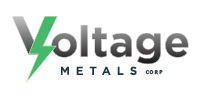TORONTO, Aug. 16, 2021 /CNW/ – Mansa Exploration Inc. (“Mansa” or the “Company”) (CSE: MANS) is pleased to announce that it has entered into a binding letter of intent dated August 13, 2021 (the “Agreement”) with Voltage Metals Inc. (“Voltage”). Pursuant to the Agreement, Mansa will acquire all of the issued and outstanding shares of Voltage in exchange for shares of Mansa (the “Transaction”). The Transaction will constitute a reverse takeover of Mansa by Voltage and will be a “fundamental change” of Mansa pursuant to the policies of the Canadian Securities Exchange (“CSE”), requiring approval from the CSE. Approval of the shareholders of Mansa and Voltage will also be required.
Shareholders of Voltage will receive an aggregate of 36,000,000 common shares in the capital of Mansa in exchange for the outstanding common shares of Voltage.
ABOUT VOLTAGE METALS INC.
Voltage is a mineral exploration company with a highly experienced team focused on the St. Laurent Project which covers 4,170 hectares and is located in St. Laurent Township, Northern Ontario, 160 kilometres northeast of Timmins, 50 kilometres south of Detour Lake Mine and 20 kilometres southwest of Casa Berardi Mine.
Past shallow drilling at the St. Laurent Project identified disseminated multi-element sulphide mineralization across notable widths trending towards a large gabbro-hosted magnetic feature. The Ni-Cu-Co-Au-Pt-Pd zone is open along strike and at depth. This mineralized zone, importantly, is coincident with a strong 600-metre long EM anomaly.
Drilling to date has not yet intersected massive sulphides, and the EM anomaly has not yet been explained. The disseminated sulphide halo provides an important vector to guide the upcoming future exploration work.
Voltage is party to a purchase agreement (the “Purchase Agreement”) dated June 20, 2020, as amended March 1, 2021, with Pancontinental Resources Corp. (“Pancon”), pursuant to which Voltage will be acquiring from Pancon a 100% interest in the St. Laurent Project, along with the Montcalm Project, the Nova Project and the Gambler Project, with the latter three projects being early-stage exploration projects located in the Montcalm Greenstone Belt, approximately 65 kilometres northwest of Timmins, Ontario. Pursuant to the terms of the Purchase Agreement, Voltage has two remaining payments to Pancon as follows: (i) $300,000 no later than September 30, 2021; and (ii) $200,000 no later than December 31, 2021.
PRIVATE PLACEMENT
Prior to or concurrently with the completion of the Transaction, it is anticipated that Mansa will carry out a private placement financing (the “Concurrent Financing“) to raise up to $2 million in gross proceeds for the purposes of funding its working capital requirements and carrying out exploration work on the properties of Voltage and Mansa. The terms of the Concurrent Financing will be determined by Voltage and Mansa.
CONDITIONS TO CLOSING TRANSACTION
A listing statement of Mansa will be prepared and filed in respect of the Transaction. Investors are cautioned that, except as disclosed in the listing statement, any information released or received with respect to the Transaction may not be accurate or complete and should not be relied upon. Completion of the Transaction is subject to a number of conditions, including, but not limited to, receipt of regulatory approval, compliance with applicable securities laws, and the receipt of all requisite shareholder approvals. Trading in the common shares of Mansa will remain halted pending review of the Transaction by the CSE. There can be no assurance that trading in the common shares will resume prior to completion of the Transaction.
QUALIFIED PERSON STATEMENT
All scientific and technical information contained in this news release was prepared and approved by Todd Keast, P. Geo, who is a Qualified Person as defined in NI 43-101.
The CSE has not, in any way, passed upon the merits of the Transaction and associated transactions and has not, in any way, approved or disapproved of the contents of this news release. The CSE has not reviewed and does not accept responsibility for the adequacy or accuracy of this news release.
ABOUT MANSA EXPLORATION
Mansa Exploration is a Canadian mineral exploration company listed on the Canadian Securities Exchange (CSE) under the symbol MANS. Mansa currently has an option to acquire a 100% interest in the 1,900-hectare Skyfire property located in the Caribou mining area of central British Columbia, Canada. Mansa may earn 100% interest by incurring an aggregate of $1,250,000 in exploration expenditures on the property by December 31, 2022. Mansa is also exploring for Ni-Cu-PGE mineralization on its 100% owned, 19,750-hectare Wheeler Property located in southwestern Newfoundland and Labrador.
FORWARD-LOOKING INFORMATION
Certain information contained herein constitutes “forward-looking information” under Canadian securities legislation. Forward-looking information includes, but is not limited to, statements with respect to the Transaction, the completion thereof and the use of proceeds. Generally, forward-looking information can be identified by the use of forward-looking terminology such as “will” or variations of such words and phrases or statements that certain actions, events or results “will” occur. Forward-looking statements are based on the opinions and estimates of management as of the date such statements are made and they are subject to known and unknown risks, uncertainties and other factors that may cause the actual results to be materially different from those expressed or implied by such forward-looking statements or forward-looking information, including the receipt of all necessary regulatory and shareholder approvals. Although management of the Company has attempted to identify important factors that could cause actual results to differ materially from those contained in forward-looking statements or forward-looking information, there may be other factors that cause results not to be as anticipated, estimated or intended. There can be no assurance that such statements will prove to be accurate, as actual results and future events could differ materially from those anticipated in such statements. Accordingly, readers should not place undue reliance on forward-looking statements and forward-looking information. The Company will not update any forward-looking statements or forward-looking information that are incorporated by reference herein, except as required by applicable securities laws.












